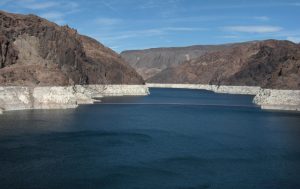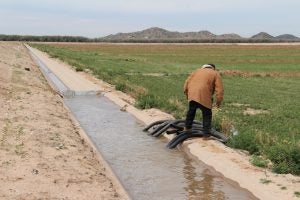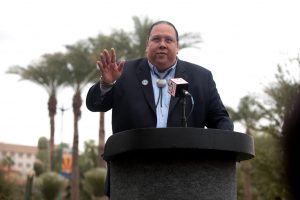4 reasons why Arizona water is on the right track

Drought is the new normal in Arizona and the Colorado River Basin. The Colorado River is over-allocated, and potential reductions in Arizona water deliveries have become more and more likely.
Just last summer, we watched Lake Mead drop to one of its lowest levels ever. And even with a wet winter this year, Lake Mead’s elevation remains low. The river that provides 40 percent of Arizona’s water supplies needs our help.
A new deal
This summer, several parties came together to sign a “system conservation” agreement to address the situation. The State of Arizona, City of Phoenix, U.S. Bureau of Reclamation, and the Walton Family Foundation agreed to compensate the Gila River Indian Community to leave 40,000 acre feet of its 2017 Colorado River water entitlement in Lake Mead.
This is about 1.3 billion gallons of water, which is roughly the amount needed to serve 100,000 people in a year. The conserved water is designated as “system water” to help keep Lake Mead from falling below 1,075 feet – the elevation at which a federal shortage declaration is triggered and water delivery reductions are mandated (as stated in the proposed Lower Basin Drought Contingency Plan between Arizona, California, Nevada and the U.S. Bureau of Reclamation).
[Tweet “4 reasons why Arizona water is on the right track, via @GrowingReturns:https://edf.org/8Bv”]
A big deal

The agreement benefits all water users in the region. It is a model of collaboration and the bold action needed to protect the health of the Colorado River system for several reasons:
- Water is being left in Lake Mead for the benefit of the river system. If all Lower Basin water users take their full entitlement of Colorado River water, Lake Mead elevation will drop 12 feet per year on average. We need more agreements like this to rebalance supply and demand.
- It marks a new era of collaboration. Local, state, federal, tribal and philanthropic organizations came together to conserve water for the benefit of the Colorado River system. The Walton Family Foundation’s contribution to funding this agreement signals growing interest outside of typical government sources for ensuring a healthy Colorado River for people and nature.
- Tribes are taking the lead on system conservation in Arizona. For generations, the Gila River Indian Community has been a ready and willing participant in addressing Arizona’s water challenges. Just last January, the tribe reached another agreement with Reclamation to conserve an additional 40,000 acre feet of its water, and additional water savings are expected in the remaining months of 2017.
- It bolsters the state’s ability to complete a drought contingency plan, aligning Lower Basin priorities and demonstrating the capacity of Arizona water stakeholders to collaborate for the benefit of the entire system. The plan is needed to prevent Lake Mead from falling to critically low levels and to establish water savings on a basin-wide scale.
A vision for the future

I was at the inspirational ceremony to mark the signing of the Gila River agreement. The event revealed a shared vision of a secure water future for Arizona and the entire region through collaboration, innovation, and smart public and private investments.
It was also a heartening reminder of the essential leadership role that Arizona’s tribes can play in crafting a secure water future. As Gila River Governor Roe Lewis put it, “Being good stewards of this most sacred resource is a part of who we are as a people and what the Gila River Indian Community has stood for across time.”
When it comes to giving back to the river that sustains us, so that we have the water we need for Arizona’s future, we are truly all in this together.
Related:
What it’s going to take to fund California’s water infrastructure >>
Leasing water – a novel idea to combat “buy and dry” in Colorado >>
Inclusion and collaboration: Governor Ducey has a new strategy for water in Arizona >>











